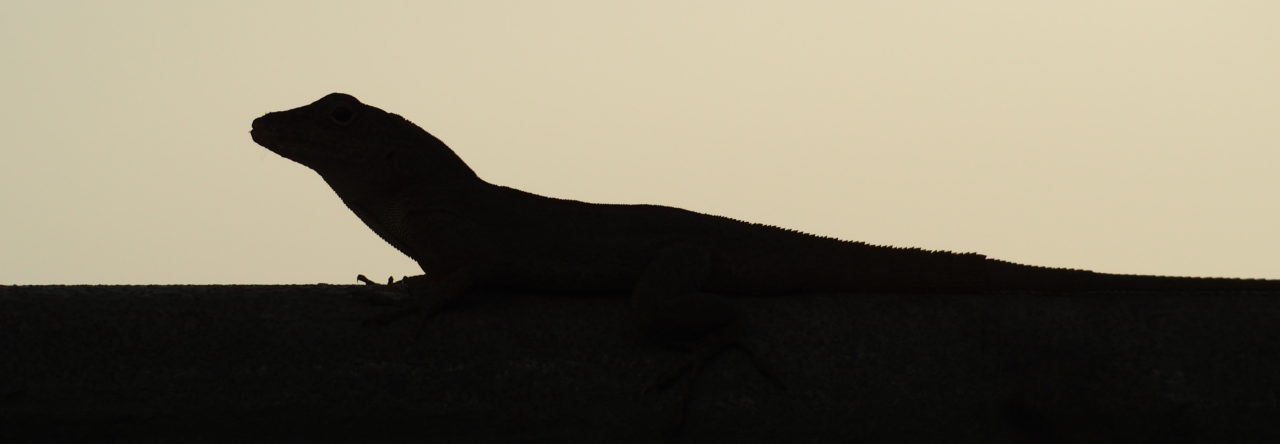
Scarlet kingsnake feeding on a green anole. Photo by J.D. Willson.
New and spiffy! Among many other features, there is an image bank of great photos, including the one above.


Scarlet kingsnake feeding on a green anole. Photo by J.D. Willson.
New and spiffy! Among many other features, there is an image bank of great photos, including the one above.

This photo’s bouncing around the internet. It’s clearly Phenacosaurus, but which one? Doesn’t look like the P. heterodermus discussed in recent posts.
 Janson Jones recalls the formative role Anolis carolinensis played in his childhood.
Janson Jones recalls the formative role Anolis carolinensis played in his childhood.
![]()
The good news: Cabela’s is selling their fabled telescoping panfish poles for $10 off (or at least, that’s what their website says–we’ve seen ordering fulfillment issues in the past)
The bad news: the non-sale price keeps going up.
Might be the right time to stock up!

Found this nice explanation of anole color change on twitter. It’s from the website of Elizabeth Nixon, a professional artist, who says that it was made in Photoshop in 40 hours. Very nicely done!

Ecuador’s most wanted! This lizard was thought to be extinct for nearly fifty years, and still after its “rediscovery” in 2005, it remains hard to locate.

Most records of Horned Anole are in disturbed areas, including near roads vegetation, botanical gardens and bamboo trees.
It took me more than two years of constant visits to Mindo, a cloud forest-town in the Western Ecuadorian Foothills, to meet with the Horned Anole (Anolis proboscis)! I always felt it was a mythological reptile, not only for Ecuadorian herps but throughout the world. Has anyone seen a lizard with a long appendix on the tip of his nose, a wide color throughout the body, prehensile tail and even spines on the back? It is difficult not to speak mystically when we refer to Horned Anole.
For over 50 years it was listed as “Possibly extinct,” until 2005, when a group of Ecuadorian scientists “rediscovered” it. But it was not until two years ago when the global and local Anole experts, led by Jonathan Losos, Steven Poe and Fernando Ayala, started several expeditions to investigate everything about its morphology, phylogeny and natural history.
The Horned Anole is a diurnal and slow-moving lizard that usually is found perched between 4-8 meters above the ground. Although most records are in vegetation on roadsides, highways and near open areas can be very difficult to find due to their excellent camouflage that blends perfectly with twigs full of mosses, lichens and epiphytes, perfectly rhyming its colorful skin.
But what use their proboscis? Sexual selection and defense of territory are the first hypotheses that leap to the mind. Science will tell us soon! But even that, we are left to enjoy its beauty and unparalleled mystique.

Definitely its silhouette is unmistakable. His sharp proboscis distinguishes it from all Ecuadorian lizards.

It can be difficult to find. Not only because they are commonly perched on high branches, but also for their camouflage, forming an ideal combination with branches and colorful leaves.

It is slow-moving and spends most of its time 450–800 cm from ground and feeds on a variety of arboreal arthropods.

Photojournalist, anole aficionado and AA has devoted yesterday’s post to the goings-on of her local brown anoles. Check it out Daffodil’s Photo Blog.
httpv://www.youtube.com/watch?v=UR_byRbXxvs
Anole researcher Anthony Herrel showed his true colors recently in a seminar when he said that chameleons are cooler than anoles. Be that as it may, this video is a fun demonstration of the amazing traits that make chameleons the second coolest lizards. It’s part of the “True Facts” series of videos, which are quite entertaining–one episode on tarsiers was featured in a recent AA post.
 Here’s a disturbing photo that came across Facebook the other day. And I always thought these katydids seemed like delightful, gentle forest nymphs. Who knew they could be vicious killers. This comes from The Biodiversity Group’s Facebook page, but I couldn’t locate the image on their website, though I didn’t look that hard. They identify the anole as A. princeps but don’t provide any further information.
Here’s a disturbing photo that came across Facebook the other day. And I always thought these katydids seemed like delightful, gentle forest nymphs. Who knew they could be vicious killers. This comes from The Biodiversity Group’s Facebook page, but I couldn’t locate the image on their website, though I didn’t look that hard. They identify the anole as A. princeps but don’t provide any further information.
Males and females of many species vary in their morphology, behavior, and physiology. Whether exaggerated weapons, elaborate coloration patterns, or dramatic differences in size, these sexual dimorphisms form some of the most eye-catching elements of biological diversity. These striking differences are often considered as a product of sexual selection, whether due to direct female choice for an elaborate structure or traits used by combative males to assert dominance. But additional patterns of dimorphism become visible with quantitative comparisons of male and female body proportions, which may yield additional clues to ecological differences between the sexes. Considering that patterns of sexual dimorphism can diverge rapidly among species it is no surprise that they have intrigued biologists since before Darwin.

Anolis brunneus from Crooked Island, Bahamas. A member of the carolinensis clade of anoles exhibiting extreme levels of facial length dimorphism.The male is the large lizard to the bottom left, the female to the upper right.
Powered by WordPress & Theme by Anders Norén